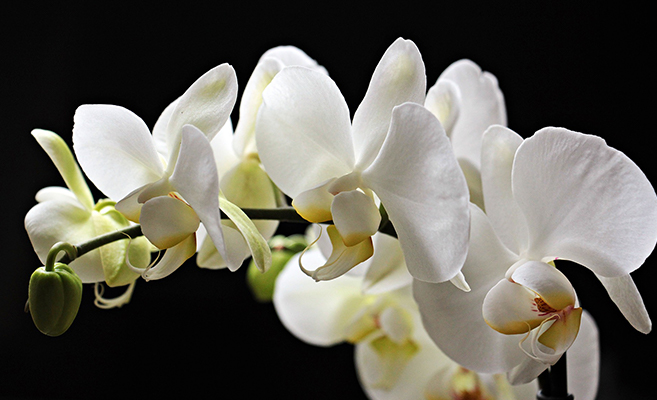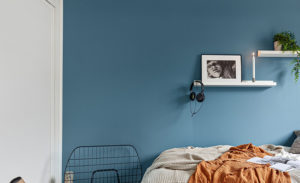Avoid not knowing which plants do best indoors and bring life and color to your home’s interior. Adding indoor flowering plants to your decor can make colors stand out and create a warm and welcoming environment.
sallywheatinteriors.com gathered essential flowering plant species information to help you select the right plants for your home’s interior design.
Indoor Flowering Plants
One of the best ways to add splashes of color to your interior design is to introduce flowering plants strategically placed on windowsills, end tables, coffee tables, or in the corners. Plants naturally improve your home’s air quality; while their green color will add a breath of life to the atmosphere, it’s when they bloom they show off your decorating vision and accentuate the appeal of your property. Consider the following five species:
1. Begonia (Begonia)
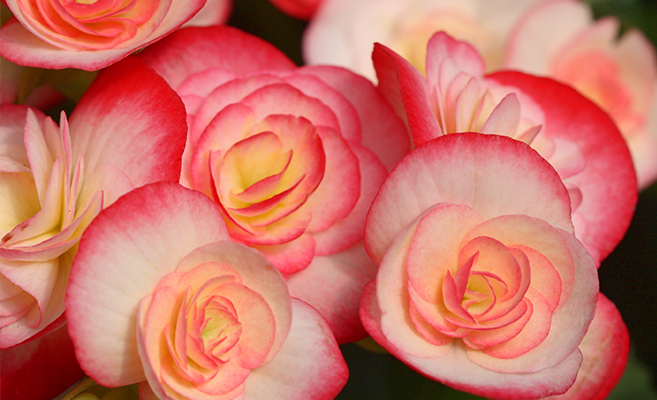
Begonias are attractive perennial herbs with soft, succulent stems and white, pink, red, orange, or yellow flowers.
Blooms – loose clusters of single or double flowers in shades of white, pink, or red, plus bicolor versions. Flowers reliably bloom throughout the growing season (May to October).
Mature Size – Begonia plants can range from a few inches to over 12 inches high. The flowers, foliage colors, and sizes are incredibly diverse.
Water – Keep soil evenly moist, allowing it to dry only slightly between waterings.
Fertilizer – When the plant is in full growth, fertilize with balanced liquid fertilizer at half strength at alternate waterings.
Best Interior Location – Flowering indoor begonias should be located in a bright spot and receive some daily direct sunlight.
Expected Lifespan – 2 to 3 years
2. Peace Lily (Spathiphyllum)
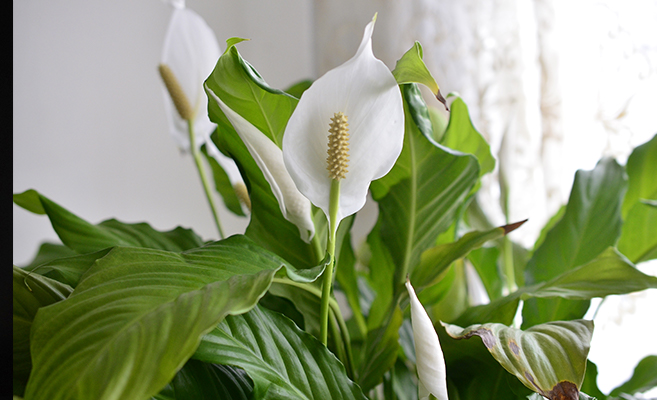
Peace lilies are sturdy, easy-to-grow plants with glossy, dark green, oval leaves that rise directly from the soil, narrowing to a point. These plants also periodically produce lightly fragrant white flowers that resemble calla lilies.
Blooms – This species will typically flower in spring, producing one or two white hooded blooms lasting over a month. They may occasionally flower again in the fall.
Mature Size – When this plant species reaches maturity, it can grow to a height of about 2 to 3 feet. Its 9-inch long and 5-inch wide, glossy, lance-shaped leaves grow on 10 to 12-inch stalks. The flower stem can be 15 to 20 inches long, and the flowers can open up to 4 inches wide.
Water – The peace lily requires consistently moist soil but do not tolerate sitting in standing water.
Fertilizer – Encourage new spring growth by fertilizing approximately every 6 weeks, starting in late winter, with a balanced houseplant fertilizer.
Best Interior Location – Bright, indirect light is best for this species, ideally sheltered from cold drafts, so choose a spot away from doors and fireplaces. Peace lilies typically thrive in humid locations like bathrooms.
Expected Lifespan – 3 to 5 years
3. African violet (Saintpaulia ionantha)
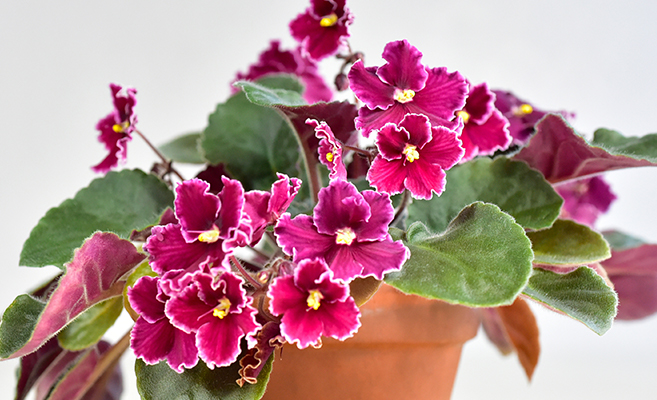
Saintpaulia ionantha, or African violet, is among the most rewarding flowering houseplants. It is a low, compact plant with beautiful dark green, thick, hairy leaves. The plant’s violet-like flowers are borne in small panicles, resting just above the foliage.
Blooms – If you provide the proper growing conditions, you can expect your African violet to bloom 10 to 12 months yearly. Each bloom typically lasts for 2 to 3 weeks.
Mature Size – African violets can reach an 8 to 16-inch diameter, depending on the variety.
Water – Only water this houseplant once weekly and allow it to completely dry between waterings.
Fertilizer – This species will thrive with fertilizer applications every four to six weeks. Any water-soluble fertilizer labeled for houseplant use will likely be adequate for African violets.
Best Interior Location – This species thrives in bright, indirect light for the best color and blooms. A stand, table, or shelf three feet away from a west- or south-facing window is an ideal location.
Expected Lifespan – Up to 50 years
4. Orchid (Orchidaceae)
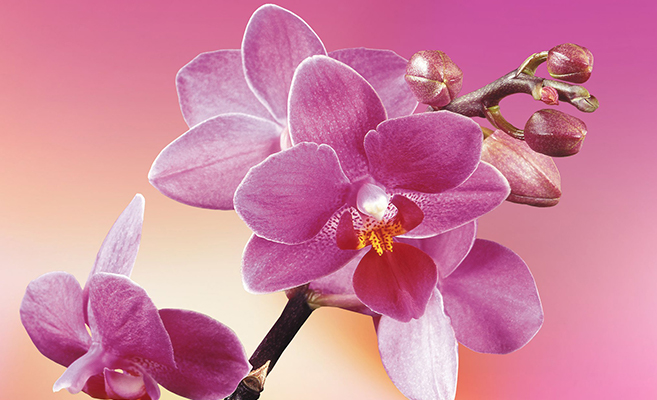
Orchids are a diverse plant family, including more than 700 genera and around 28,000 individual species. Orchids are perfect for decorating, with their beautiful colors and unique shape. They belong to one of the largest plant families, and its members are identified by a typical bilateral symmetry of the flowers with upward-facing petals.
Blooms – Orchid flowers come in varied colors depending on the variety. They have three sepals, three petals, and a three-chambered ovary. The three sepals and two of the petals are often similar to each other, while one petal is modified, forming an elegant lip.
Mature Size – Orchid leaves are typically 8 to 12 inches long, while the flowers are 3 to 5 inches across.
Water – Most orchids can be watered once a week to 10 days. Be careful not to oversaturate them.
Fertilizer – Orchids should be fed regularly. Use a “balanced” fertilizer like a 20-20-20 mix that includes all necessary trace elements with little or no urea.
Best Interior Location – The ideal spot for growing orchids is either in south or east-facing windows.
Expected Lifespan – 10 to 15 years
5. Christmas Cactus (Schlumbergera bridgesii)
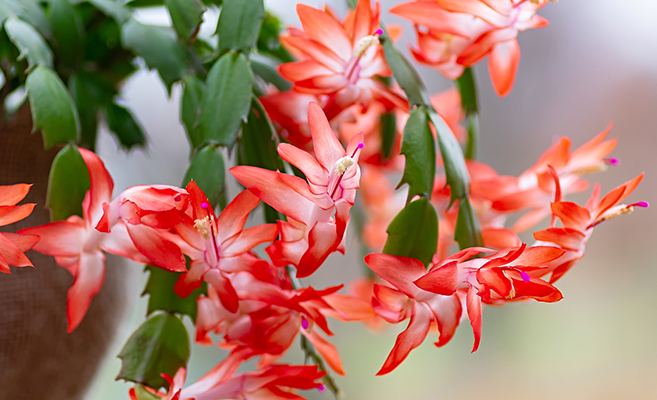
This is a popular Cactaceae family species with flattened stems and grown for its striking cerise flowers, blooming indoors around Christmastime in the Northern Hemisphere.
Blooms – This species produces colorful, tubular flowers in pink or lilac shades. Its beautiful flowers, lasting bloom time, and easy care requirements make this a highly sought-after houseplant.
Mature Size – This plant can reach a mature size of 12 inches in height with a 2-foot spread.
Water – Water your plant every 2-3 weeks (only water when the top one-third of the soil is dry to the touch).
Fertilizer – Fertilize your plant monthly (from the time new growth begins in late winter or early spring and throughout the summer with a one-half strength liquid fertilizer, like a 20-20-20 mix.
Best Interior Location – An east-facing window or a bright bathroom is ideal for this incredible plant. However, too much direct sunlight can bleach its sensitive leaves.
Expected Lifespan – Up to 100 years
Flowering Houseplants
In this article, you discovered indoor flowering plant species that complement your property’s interior design while adding a spark of life and beauty to the room.
Adding flowering houseplants to your decor can help purify the air while adding distinct splashes of color and timeless beauty to its layout and design.
Without knowing the best indoor plants, you will either waste money guessing, or your home will fall short of its potential.
Sources:
hgic.clemson.edu/factsheet/growing-begonias-indoors/
gardeningsolutions.ifas.ufl.edu/plants/houseplants/peace-lily.html
dodge.extension.wisc.edu/master-gardener/african-violets-bringing-beauty-indoors/
warren.cce.cornell.edu/gardening-landscape/warren-county-master-gardener-articles/orchids-as-houseplants
extension.umn.edu/houseplants/holiday-cacti
